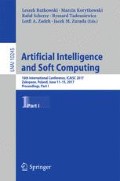Abstract
In this paper, we consider a multi-objective portfolio diversification problem under real constraints in fuzzy environment, where the objective is to minimize the variance of portfolio and maximize expected return rate of portfolio. The return rates of assets are modeled using concept of Ordered Fuzzy Candlesticks, which are Ordered Fuzzy Numbers. The use of them allows modeling uncertainty associated with financial data based on high-frequency data. Thanks to well-defined arithmetic of Ordered Fuzzy Numbers, the estimators of fuzzy-valued expected value and covariance can be computed in the same way as for real random variables. In an empirical study, 20 assets included in the Warsaw Stock Exchange Top 20 Index are used to compare considered fuzzy model with crisp mean-variance model.
Access this chapter
Tax calculation will be finalised at checkout
Purchases are for personal use only
Notes
- 1.
For Ordered Fuzzy Number which can be represented as classical convex fuzzy number.
References
Carlsson, C., Fuller, R., Majlender, P.: A possibilistic approach to selecting portfolios with highest utility score. Fuzzy Sets Syst. 131, 13–21 (2002)
Dubois, D., Prade, H.: Fuzzy Sets and Systems: Theory and Application. Academic Press, New York (1980)
Długosz, A., Jarosz, P.: Multiobjective optimization of electrothermal microactuators by means of Immune Game Theory Multiobjective Algorithm. In: Kleiber, M., et al. (eds.) Advances in Mechanics: Theoretical, Computational and Interdisciplinary Issues, pp. 141–145. Taylor & Francis Group, London (2016)
Huang, X.X.: Mean-semivariance models for fuzzy portfolio selection. J. Comput. Appl. Math. 217(1), 1–8 (2008)
Jarosz, P., Burczyski, T.: Coupling of immune algorithms and game theory in multiobjective optimization. In: Rutkowski, L., Scherer, R., Tadeusiewicz, R., Zadeh, L.A., Zurada, J.M. (eds.) ICAISC 2010. LNCS (LNAI), vol. 6114, pp. 500–507. Springer, Heidelberg (2010). doi:10.1007/978-3-642-13232-2_61
Jarosz, P., Burczyński, T.: Biologically-inspired Methods and Game Theory in Multi-criterion Decision Processes. In: Bouvry, P., et al. (eds.) Intelligent Decision Systems in Large-Scale Distributed Environments, Studies in Computational Intelligence 362, pp. 101–124. Springer, Heidelberg (2011)
Konno, H., Yamazaki, H.: Mean-absolute deviation portfolio optimization model and its applications to Tokyo stock market. Manage. Sci. 37, 519–531 (1991)
Konno, H., Shirakawa, H., Yamazaki, H.: A mean-absolute deviation-skewness portfolio optimization model. Ann. Oper. Res. 45, 205–220 (1993)
Kosiński, W., Prokopowicz, P., Ślȩzak, D.: Drawback of fuzzy arithmetic - new intuitions and propositions. In: Burczyński, T., Cholewa, W., Moczulski, W. (eds.) Proceedings PACM, Methods of Artificial Intelligence, Gliwice, pp. 231–237 (2002)
Kosiński, W., Prokopowicz, P., Ślȩzak, D.: On algebraic operations on fuzzy numbers. In: Klopotek, M., Wierzchoń, S.T., Trojanowski, K. (eds.) Intelligent Information Processing and Web Mining, pp. 353–362. Springer, Heidelberg (2003)
Kosiński, W., Prokopowicz, P., Ślȩzak, D.: Ordered fuzzy numbers. Bull. Polish Acad. Sci. Ser. Sci. Math. 51(3), 327–338 (2003)
Kosiński, W., Prokopowicz, P.: Algebra of fuzzy numbers mathematica applicanda. J. Polish Math. Soc. 32(46/05), 37–63 (2004)
Kosiński, W.: On soft computing and modelling. Image Process. Commun. 11(1), 71–82 (2006)
Kosiński, W., Frischmuth, K., Wilczyńska-Sztyma, D.: A new fuzzy approach to ordinary differential equations. In: Rutkowski, L., Scherer, R., Tadeusiewicz, R., Zadeh, L.A., Zurada, J.M. (eds.) ICAISC 2010. LNCS (LNAI), vol. 6113, pp. 120–127. Springer, Heidelberg (2010). doi:10.1007/978-3-642-13208-7_16
Liu, B., Liu, Y.-K.: Expected value of fuzzy variable and fuzzy expected value models. IEEE Trans. Fuzzy Syst. 10, 445–450 (2002)
Liu, Y.-K., Liu, B.: Fuzzy random variables: a scalar expected value operator. Fuzzy Optim. Decis. Making 2, 143–160 (2003). Kluwer Academic Publishers, Printed in The Netherlands
Markowitz, H.M.: Portfolio selection. J. Financ. 7(1), 77–91 (1952)
Markowitz, H.M.: Portfolio selection: efficient diversification of investments. Cowles Fundation for Research in Economics at Yal University. Monograph 16. Wiley, New York (1959)
Markowitz, H.M.: Mean-Variance Analysis in Portfolio Choice and Capital Markets. Basil Blackwell, Oxford (1987)
Marszałek, A., Burczyński, T.: Financial fuzzy time series models based on ordered fuzzy numbers. In: Pedrycz, W., Chen, S.-M. (eds.) Time Series Analysis, Model & Applications, ISRL 47, pp. 77–95. Springer, Heidelberg (2013)
Marszałek, A., Burczyński, T.: Modelling financial high frequency data using ordered fuzzy numbers. In: Rutkowski, L., Korytkowski, M., Scherer, R., Tadeusiewicz, R., Zadeh, L.A., Zurada, J.M. (eds.) ICAISC 2013. LNCS (LNAI), vol. 7894, pp. 345–352. Springer, Heidelberg (2013). doi:10.1007/978-3-642-38658-9_31
Marszałek, A., Burczyński, T.: Modeling and forecasting financial time series with ordered fuzzy candlesticks. Inf. Sci. 273, 144–155 (2014)
Murphy, J.J.: Technical Analysis of the Financial Markets. New York Institute of Finance, New York (1999)
Tanaka, H., Guo, P.: Portfolio selection based on upper and lower exponential possibility distributions. Eur. J. Oper. Res. 114, 115–126 (1999)
Sharpe, W.F.: The sharpe ratio. J. Portfolio Manage. 21(1), 49–58 (1994)
Zadeh, L.A.: Fuzzy sets. Inf. Control 8, 338–353 (1965)
Zhang, W.G., Zhang, X.L., Xiao, W.L.: Portfolio selection under possibistic mean-variance utility and SMO algorithm. Eur. J. Oper. Res. 197(2), 693–700 (2009)
Author information
Authors and Affiliations
Corresponding author
Editor information
Editors and Affiliations
Rights and permissions
Copyright information
© 2017 Springer International Publishing AG
About this paper
Cite this paper
Marszałek, A., Burczyński, T. (2017). Fuzzy Portfolio Diversification with Ordered Fuzzy Numbers. In: Rutkowski, L., Korytkowski, M., Scherer, R., Tadeusiewicz, R., Zadeh, L., Zurada, J. (eds) Artificial Intelligence and Soft Computing. ICAISC 2017. Lecture Notes in Computer Science(), vol 10245. Springer, Cham. https://doi.org/10.1007/978-3-319-59063-9_25
Download citation
DOI: https://doi.org/10.1007/978-3-319-59063-9_25
Published:
Publisher Name: Springer, Cham
Print ISBN: 978-3-319-59062-2
Online ISBN: 978-3-319-59063-9
eBook Packages: Computer ScienceComputer Science (R0)

